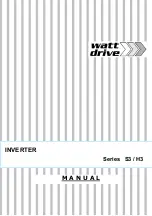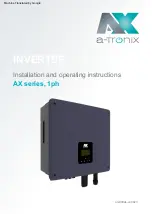
SAMLEX AMERICA INC. | 19
For details of programming this mode, please refer to Fig 10.1 / Table 10.1 under Main Menu for Parameter
Group 3 – "Output Setup" / Sub Menu for Parameter Group 3, Parameter (d) – "Inverter Mode" (Section 10.2.3.4).
Off-line Mode is so-called because the load is fed directly from the raw AC GRID input during normal
operation, rather than from the conditioned Inverter output. To that extent, the energy storage
components – charger (not included in this unit and is to be provided externally), battery and Inverter
– are off-line as far as the load is concerned, although the charger and battery remain connected to the
AC GRID input to ensure that the battery is always fully charged. If the AC GRID input voltage fails, or
exceeds the limits of “synchronizable frequency window” determined by the programmable parameter
“SyncFREQ” (see Section 5.6.4), the load is transferred to the backup Inverter almost immediately. During
this changeover, there is an inevitable break in power to the load of < 8 ms. In practice, most loads can
hold up through this period without any problems.
A more serious objection to Off-line Mode is that the load is continuously exposed to spikes, transients
and any other aberrations coming down the AC GRID input, creating a risk of loss or damage to sensitive
equipment and data.
5.5.2 On-line Mode:
In this mode, the Inverter is the primary source of power and the AC GRID input is
the backup source of power.
For details of programming this mode please refer to Fig 10.1 / Table 10.1 under Main Menu for Parameter Group
3 – "Output Setup" / Sub Menu for Parameter Group 3, Parameter (d) – "Inverter Mode" (Section 10.2.3.4).
As compared to the Off-line Mode described at Section 5.5.1 above, in On-line Mode, the AC load is
supplied by the conditioned power from the Inverter rather than raw, unconditioned power from the AC
GRID input. On-line Mode is often called ‘Double Conversion’ type because incoming power is converted
once to DC, for the battery, and then back to AC by the Inverter before reaching the load – which is,
therefore, well-insulated from the AC GRID input. In case the Inverter voltage fails, the load is transferred
to the backup provided by AC GRID input.
5.6 SYNCHRONIZED AND UNSYNCHRONIZED TRANSFER THROUGH PROGRAMMABLE
PARAMETER “TRANSFER TYPE”
5.6.1
This unit is designed to function as an Uninterruptible Power Supply (UPS) System. In a UPS, there is
Primary AC Source that supplies the load through a Transfer Switch and a Backup AC Source that takes over
the load when the load is transferred from the Primary AC Source to the Backup AC Source.
Programmable parameter called “Transfer Type” has been provided to select either “Synchronized” or
“Unsynchronized” transfer. “Synchronized” Type is the default selection. For programming details, refer to
Fig 10.1 / Table 10.1 under Main Menu for Parameter Group 3 – "Output Setup" / Sub Menu for Parameter
Group 3, Parameter (e) – "Transfer Type" (Section 10.2.3.5).
5.6.2 Synchronized Transfer and Advantages
When current flowing through inductive type of loads such as transformers, fans, pumps, compressors etc.
is interrupted, the inductive components of the load generate back EMF voltage at the load terminals. This
back EMF voltage is at the same frequency as the AC input source and will dissipate within a finite time of
up to hundreds of millisecs. Assume that Primary AC Source is supplying current to the above inductive type
SECTION 5 |
Description & Principles of Operation
















































